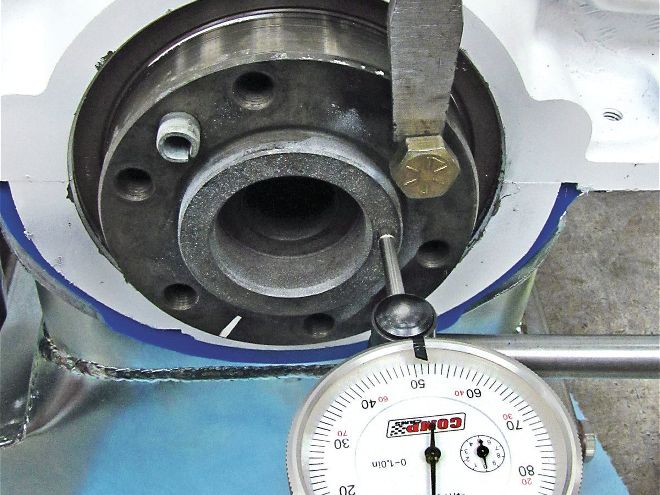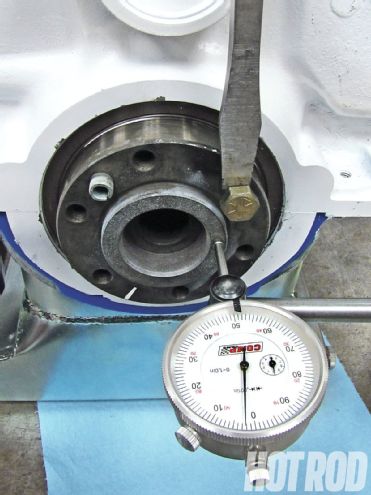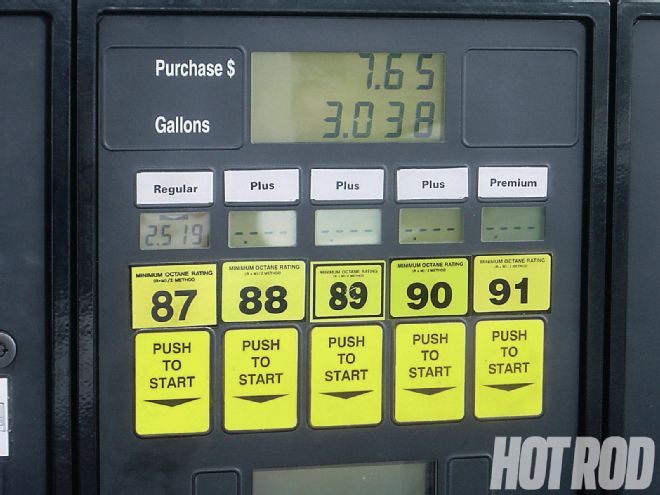
Q: I just installed a 305 engine into my ’86 El Camino. When I went to install the bolts on the torque converter, I pried it a little with a screwdriver until it mated with the flexplate and the crankshaft moved forward. After installing all the torque-converter bolts, I did it again—the crank moves front and back. Is this normal? If not, what do I do about it?
A: An engine’s crankshaft is supported in the engine block by the main bearings. The bearings and the oil film between the bearings and crank must be able to contain, absorb, and manage loads induced by the combustion process driving the pistons and rods. These loads encompass both radial (spinning) and longitudinal (fore and aft) forces. As the pistons drive the crank around the crankshaft axis (the radial loading), they also try to drive the crank toward the rear (the longitudinal loading). Although all the main bearings are designed to cope with radial loads, one of these bearings—the thrust bearing—also works to contain and absorb the longitudinal loads. The thrust bearing usually has an added flange that corresponds to a flanged surface or journal machined on the crankshaft. Ideally, the bearings and the crank never come into physical contact; instead, under running conditions, they are separated and protected by an oil film or wedge. Bearing clearance is the air gap that is filled by the oil’s hydrodynamic wedge when the engine is running.
The main-bearing clearance spec is the static clearance between the main-bearing shells and the crankshaft main journals, but for the purposes of controlling longitudinal loads the important spec is the clearance between the main-thrust bearing flange and crankshaft main-thrust surface or journal. This clearance value corresponds to the permissible amount of front-to-rear movement of the crankshaft in the block. On traditional small-block and big-block Chevrolet V8 engines, the thrust bearing is the rearmost bearing (No. 5 main bearing). On other engines—including LS-series small-blocks—the center main bearing (No. 3 on most V8s) may serve as the thrust bearing.
 Endplay can be checked with the oil pan in place, as seen here on a late GM Gen V big-block at Westech Automotive. Set up the dial indicator on the crank flywheel flange or flywheel, then pry the crank back and forth. For an in-car check, the trans must be removed or (clearance permitting) at least slid back out of the way. Disconnect any crank-driven front belts as well.
Endplay can be checked with the oil pan in place, as seen here on a late GM Gen V big-block at Westech Automotive. Set up the dial indicator on the crank flywheel flange or flywheel, then pry the crank back and forth. For an in-car check, the trans must be removed or (clearance permitting) at least slid back out of the way. Disconnect any crank-driven front belts as well.
Provided it’s within manufacturers’ specs, some crankshaft movement is necessary and normal, but either insufficient or excessive movement outside the normal range can eventually damage other parts. On a traditional small-block Chevy, the endplay should be 0.002–0.006 inch. An in-service daily driver may slide by with up to 0.010 inch without problems. Anything over 0.015 is asking for trouble. Most current-day engines (including LS engines) call for much tighter endplay values than these, so always consult a factory service manual.
The best way to check endplay is with a dial indicator installed with its plunger parallel to the crankshaft axis. On a newly assembled engine, before tightening down the main cap for the thrust bearing, first seat the bearing by smacking the crank snout and flywheel flange with a soft-headed mallet. Finish tightening all the main caps. Pry the crank backward and forward with a long screwdriver and record the indicator readings. The total travel is the crankshaft thrust clearance.
If there’s excess endplay on a fresh motor, it may be because the block and crank weren’t properly dressed or ground in the thrust area, the crank is bent, or the main-bearing thrust cap and journal are cocked (usually because the line hone is off). One way to isolate a cocked-cap problem is to check endplay before and after cap installation; if it changes, the cap was incorrectly machined or installed. Though rare, there can also be a wrong-size or wrongly manufactured thrust bearing.
Symptoms of excess crankshaft endplay in an in-service engine with a manual transmission include a deep knocking sound, typically when applying and releasing the clutch. It’s harder to notice excessive endplay if running an automatic transmission, as it may only sound like a single thud during acceleration or deceleration.
What’s the end result If endplay is too tight? The crank can bind, causing serious damage to the engine block. On the other hand, if the endplay is too loose, it can cause thrust-bearing flange failure, crank thrust-flange damage, accelerated main-bearing wear in general, timing-gear and timing-chain wear and alignment problems, connecting-rod and piston-alignment issues (especially if the piston pins are pressed instead of free floating), and, in extreme cases, actual crank counterweight and/or connecting-rod contact with the block. With an automatic transmission, excessive thrust-clearance may also screw up the tranny’s front seal and wear the front pump housing. On a manual trans, there may be shifting problems.
Conversely, a transmission problem can sometimes cause the thrust bearing to gall or burn from excessive loading. Overly high auto-trans line pressure may cause the torque converter to balloon (i.e. get wider, as viewed from the side), generating more force against the crank. High line pressures may be caused by a poorly engineered transmission-shift-improvement kit or misadjusted throttle-valve (TV) linkage on those transmissions utilizing such linkage (as on a GM 200-4R or 700-R4). Race-engine output exceeding the converter’s capacity may also create ballooning, which is why today’s high-end converters usually incorporate an anti-ballooning plate.
On a manual trans, a full-race clutch pressure plate with killer engagement pressures or constantly holding the clutch pressure down to the floor are also known to cause excessive thrust-bearing wear.
Too little thrust-bearing clearance is relatively easy to fix at home if you don’t mind tearing apart the motor. Clearance may be increased by carefully sanding the more lightly loaded front side of the thrust bearing incrementally as needed. A flat piece glass makes for a good surface plate. Place a square piece of 600-grit wet/dry sandpaper saturated with solvent on the plate, and sand the bearing’s thrust surface using a figure-eight motion to ensure even material removal.
Too much thrust clearance is a harder nut to crack. A competent machine shop would need to build up the crankshaft thrust surface by welding additional material onto its flange. At that point, it may be more economical to just get another crank.
Contact
WestechAuto.com
87-Octane Gas
Why is 87-octane unleaded regular gas still 87 octane when 10 percent ethanol is added? You would think that the ethanol would increase the octane level. Is this because there isn’t enough ethanol to do the job, or is it because the refineries are using lower-grade stock to make the gas?f
Mike Wozniak
Batavia, NY
It could be any of the above. Yup, there are several factors in play here, so it’s another one of those “it depends” questions. First, the pump’s “87-octane” sticker is merely a lawyer-like baseline CYA deal that formally lists the minimum allowable octane for regular gasoline that can be sold in low-altitude areas (those areas where 80 percent of an individual county is under 4,000 feet above sea level). However, the effective octane (as calculated by the R+M/2 method) can, and sometimes does, go higher than the minimum value posted on the sticker. According to gasoline expert Tim Wusz at Rockett Brand Racing Fuel, it depends on the baseline hydrocarbon stock, seasonal and regional variations, the mix of overall hydrocarbon products being “cracked” at a particular refinery, and how the refinery itself is set up and designed to produce most efficiently. So in some cases a particular refinery makes a sub–87-octane gasoline base-stock and then adds ethanol to the fuel to bring the octane up to the 87-octane minimum. In other cases the refinery starts with an 87-octane gasoline and then adds to it, thereby increasing the octane above the minimum required value. Why bother? One reason is that some metropolitan areas are mandated to have “reformulated” (or oxygenated) fuel with up to 10 percent ethanol at certain times of the year for emissions-control purposes, and (taking into account the other factors discussed) it may be simpler to just add it in to the particular refinery’s normal fuel blend.
 Rare sight: a single pump installation with five different octane ratings available. According to photographer Bobak Ha’Eri, the photo was taken back in 2006 “somewhere near the Missouri/Iowa border.” Dig the $2.51/gallon price for regular!
Rare sight: a single pump installation with five different octane ratings available. According to photographer Bobak Ha’Eri, the photo was taken back in 2006 “somewhere near the Missouri/Iowa border.” Dig the $2.51/gallon price for regular!
Incidentally, if 80 percent of an entire county is above 4,000 feet, a subregular 85-octane gas is allowed because an engine’s octane requirement decreases with altitude.
Contact
Rockett Brand Racing Fuel; Mt. Prospect, IL; 847.795.8400; RockettBrand.com
LS in Early Chevy II Headers Available
Some time ago, Pit Stop answered a question about swapping an LS engine into an early Chevy II (Mar. ’11, “Classic Small-Block or LS into Early Chevy Nova?”). You indicated that TrailBlazer exhaust manifolds should work with a first-gen Nova because “they hug the block tightly and have a dropped rear exit.” Unfortunately, I have found that the exhaust-flange exit on the driver side will interfere in the area where the front clip bolts onto the body near the steering column.
You also stated that the available aftermarket headers for this swap require a rack-and-pinion steering conversion and sometimes an entire new front suspension and subframe as well. This has been true up to now, but I have found out that Church Boys Racing (CBR), which already makes long-tube headers that require the different steering setup, is also working on shorty headers that will fit with the stock sheetmetal, steering box, and front subframe. Although CBR is not the cheapest around, it recognizes that the economy is very unstable, which is why they wanted to make another header for guys on a budget. You can find out about late-breaking performance Chevy II/Nova how-to and performance parts information on StevesNovaSite.com.
Casey Seitz
Peoria, AZ
Thanks for bringing this updated information to my attention. I should have originally made it clear that while TrailBlazer exhaust manifolds are the tightest-fitting factory LS exhaust manifolds my sources were aware of, at the time I wrote the original response, their fit had not been positively verified in the case of an old Chevy II in particular.
Fortunately, you no longer have to worry about making stock exhaust manifolds fit. First, Church Boys Racing has finally released its midlength swap headers for ’62–’67 LS engine swaps. These headers not only fit cars with a totally stock suspension, subframe, steering, and sheetmetal but also accommodate rack-and-pinion setups and most aftermarket bolt-on front clips. Constructed from 100 percent TIG-welded, Type 304 stainless steel, its new headers feature 1¾-inch-od, 16-gauge primary tubes; 3-inch collectors; heavy-duty, 3⁄8-inch-thick, CNC laser-cut flanges; smooth-formed collectors with a 3-inch slip-joint exhaust connection; and oxygen sensor bungs. Also included are mounting bolts, silicone sealer, and engine-mounting plates. The $659 headers have a lifetime guarantee. Three-inch-od head-pipes to route the exhaust down and under the chassis plus attaching band-clamps are another $150.
In the past year, BRP Hot Rods has also introduced complete LS engine and T56 and 4L60E trans swap kits for the early Chevy II. It offers two different ceramic-coated, long-tube header sets that work with its kits and the stock steering and subframe: one with 1¾-inch primary tubes; the other configuration has 1¾ -to-17⁄8-inch stepped primaries.
Contacts
BRP Hot Rods Inc.; Cumming, GA; 770.751.0687; BRPHotRods.com
Church Boys Racing (CBR); Bristolville, OH; 330.442.7162; ChurchBoysRacing.com
Ford 429-460 and C6 into 1972 Cougar with factory 351C/FMX
I have a 1972 Cougar with a 351-Cleveland engine backed by a FMX automatic transmission. Am I able to put a 429/460 engine with a C6 automatic transmission into the Cougar?
Dave Senecal
Via email
The 1971-1973 Mustang and Cougar are virtually identical under the sheetmetal. In fact, the third-generation Mustang/Cougar chassis was designed to accommodate a 429 from the get-go with no shock-tower or other front chassis clearance issues. The big-block was a factory-installed option in 1971. In the unlikely event you do find one of those rare big-block cars to cannibalize, just transfer everything over. Otherwise, procure 1971 big-block engine mounts (the “rubbers”) and frame stands. The engine mounts are available from any decent auto parts store (such as NAPA PN BK 6021695, lefthand and PN BK 6021694, righthand). However, the frame brackets can be hard to find. Crites Restoration offers a 1971–1973 Mustang/Cougar 429/460 installation kit that contains the brackets, engine mounts, and engine mount bolts. Total Performance has similar parts for this swap.
As for exhaust, standard and Cobra Jet (CJ) heads have different exhaust ports; use the proper exhaust manifolds or aftermarket headers that match the style of your heads. Headers are available from several sources. Hooker is a popular choice, selling two different full-length configurations for ’71–’73 429/460 Mustangs and Cougars: one fits standard heads, the other is for CJ heads. Either set works with both automatic and manual transmissions, and they’ll also fit with power steering and A/C (not always the case with aftermarket headers for these chassis). The Cobra Jet headers won’t clear original factory oil coolers, however.
Hooker ’71–’73 Mustang/Cougar Headers Part No.* Head Type Dimensions (Inches) PRIMARIES COLLECTOR EXIT-STYLE 6115 Standard 17/8 x 35 3½ x 10 Under-chassis 6201 Cobra Jet 21/8 x 37 3½ x 10 One tube over right frame*For metallic ceramic coating add “-1” to the basic part number.
Use a 429/460 production (or aftermarket equivalent) front-sump oil pan and corresponding oil pump pickup for a passenger car (not a truck). Any ’70-and-later 429/460 standard-rotation factory water pump should work; 429/460 passenger-car front drives and accessories must be used. A larger radiator will probably be needed; this should not be a problem—just order the radiator and hoses as if you had a ’71 big-block car.
The C6 trans must come from a big-block 429/460, a 351M, or a 400—not an FE big-block, a Windsor small-block, or a standard-deck height Cleveland small-block. You must use a 429/460 flexplate. The 1979-and-later 460s were externally balanced; earlier 460s and all 429s were internally balanced—flexplates must correspond. The torque converter mounting-bolt-pattern and pilot-diameter must be compatible with the flexplate—there are several variations. The existing trans mount should work, but the C6 mount pad is lower compared to the FMX. Rework the trans crossmember or procure the correct C6 crossmember (contract Crites or Total Performance).
Most C6 transmissions were column-shifted, but your Cougar probably has a floor-shift. If the shift-lever coming out of the C6 faces down, it is a column-shift trans; floor-shift linkage is designed to attach to an upward-facing shift-lever. To go from column- to floor-shift, pull the transmission’s oil pan and the valvebody. Loosen the locknut on the shift lever. Pull the lever out of the trans and rotate it 180 degrees. Reinstall the lever in the trans, making sure the inside shift-lever is correctly engaged like it was before you pulled it out. Reinstall the valvebody and pan. If the actual length of the lever attached to the shifter does not allow sufficient shift-cable travel to correctly operate all gears and/or the detent alignment is off, TCI offers a multihole, multiposition universal Ford shift-lever (PN 418400).
The C6 is longer than an FMX, so the driveshaft must be correspondingly shortened about 3 inches (assuming the typical C6 13½-inch extension housing length). However, both the C6 and FMX do use a 31-spline yoke—just be sure you get a C6 set up for the slip-yoke, not a bolt-on companion-flange.